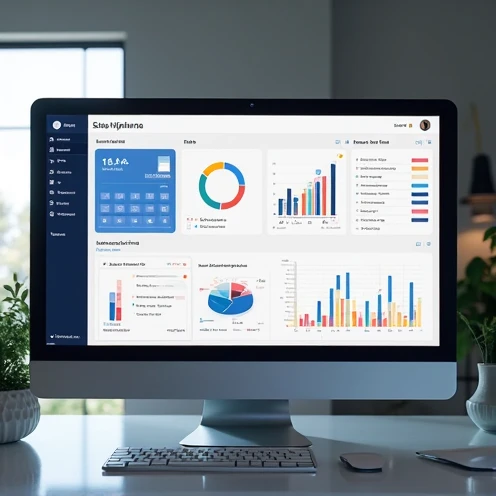The importance of CRM ERP Integration for modern business
If you’re running a modern business, you already understand how important it is to manage your operations and customer relationships effectively. But many companies still use CRM and ERP systems separately, leading to data gaps, inefficiencies, and communication breakdowns. CRM ERP Integration solves this. It bridges the gap between front-end customer interactions and back-end operations. When done right, it creates a seamless flow of data, improves decision-making, and delivers a far better customer experience.
What are CRM and ERP systems?
Iklan Google AdSense
CRM stands for Customer Relationship Management. It helps manage sales, marketing, and customer service interactions. ERP, on the other hand, stands for Enterprise Resource Planning. It handles functions like inventory, accounting, procurement, and HR.
Together, these two systems hold all the essential information needed to run a business efficiently. But when they’re disconnected, teams often work in silos and duplicate efforts, which wastes time and resources.
Iklan Google AdSense
Why integration matters more than ever
Today’s business environment demands speed and accuracy. Customers expect quick answers, while internal teams need access to real-time information to do their jobs. CRM ERP Integration ensures every department works from the same data source — reducing errors, saving time, and improving collaboration across your organization.
Key benefits of CRM ERP Integration
The benefits are broad and measurable. First, there’s improved visibility. Sales, marketing, finance, and operations can all view the same customer profile, order status, and payment history.
Second, automation becomes simpler. You can set triggers — like sending an invoice automatically when a deal is closed. It reduces manual work and improves accuracy. Finally, integrated systems support better forecasting by combining financial and sales data in one view.
Enhance customer experience through unified platforms
A seamless customer experience depends on quick responses and accurate information. When CRM and ERP systems are integrated, your support team can view delivery schedules, invoices, and product availability without switching systems or contacting another department.
This kind of access boosts customer trust and speeds up resolution times. Customers don’t want to be transferred multiple times for simple updates. Integration makes it possible to provide fast, accurate answers.
Unify your sales and finance teams
Sales and finance teams often struggle to stay aligned. The sales department wants to close deals, while finance wants to manage risk. With CRM ERP Integration, both teams can access shared financial data, such as outstanding invoices or customer credit limits.
This helps sales reps avoid closing deals with high-risk clients and lets finance departments generate invoices automatically. It not only reduces friction but also improves cash flow.
Inventory management becomes smarter
One of the strongest advantages of integration is in inventory and order management. A CRM ERP Integration ensures that every new sale immediately reflects in stock levels and shipping schedules.
That means your sales team won’t sell items that are out of stock, and your logistics team can start processing orders as soon as they’re confirmed. Customers get their products faster, and your team avoids costly mistakes.
Data-driven decisions from centralized reporting
Another reason CRM ERP Integration is essential is because it simplifies reporting. Instead of juggling reports from different platforms, decision-makers can access a single dashboard that includes both customer behavior and financial data.
This leads to smarter forecasting and strategic planning. You can spot patterns, understand which customers are most profitable, and allocate resources more effectively based on actual insights — not guesses.
Employees work faster and more effectively
Switching between systems is a waste of time. With integrated tools, employees don’t need to duplicate data or manually sync records. Updates in one system reflect instantly in the other.
This reduces human error and frees up time for more strategic work. Teams also communicate better, because everyone is referencing the same data — leading to smoother collaboration and fewer misunderstandings.
Cloud-based integration: faster, cheaper, and scalable
Thanks to cloud platforms, CRM ERP Integration is no longer limited to enterprise giants. Even startups and SMEs can now benefit from plug-and-play integrations. Cloud-based solutions are faster to deploy, more secure, and easily scalable.
Middleware tools like Zapier, Workato, or MuleSoft can connect leading CRM platforms like HubSpot or Salesforce with ERP systems like NetSuite or Odoo, enabling automation without writing custom code.
Avoiding common CRM ERP Integration challenges
While integration offers powerful benefits, it’s not without challenges. One common pitfall is poor planning. Jumping into integration without defining workflows can lead to chaos. Start with clear goals and identify what data needs to flow between systems.
Also, pay attention to compatibility. Some older ERP systems may not support open APIs. In that case, you may need middleware to act as a translator between your platforms.
Choosing the right software combination
The best integrations happen when CRM and ERP tools are designed to work together. Microsoft Dynamics offers both systems under one umbrella, making integration seamless. Oracle, SAP, and Salesforce also offer powerful native and third-party connectors.
If you’re using a mix of tools, like Salesforce and QuickBooks, focus on APIs, automation support, and vendor documentation. Choosing tools with a strong ecosystem ensures smoother integration now and in the future.
Real-world success stories from integration
Let’s look at a practical example. A fast-growing eCommerce company connected their Zoho CRM to their ERPNext system. As a result, their order processing time dropped by 30%, and customer satisfaction scores rose significantly.
Another firm in B2B logistics integrated HubSpot CRM with SAP Business One. The integration allowed their support agents to track delivery updates and payment history in real-time, reducing ticket resolution time by over 40%.
What’s next for CRM ERP Integration?
The future is even more promising. With AI and predictive analytics becoming part of CRM and ERP systems, integration will soon enable businesses to predict customer needs, optimize inventory in real-time, and offer proactive support.
Integration is not just about connecting systems — it’s about creating intelligence. And that’s where real competitive advantage lies.
Iklan Bersponsor Google






